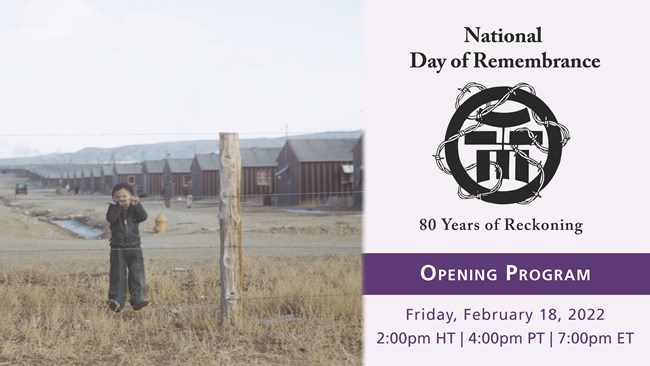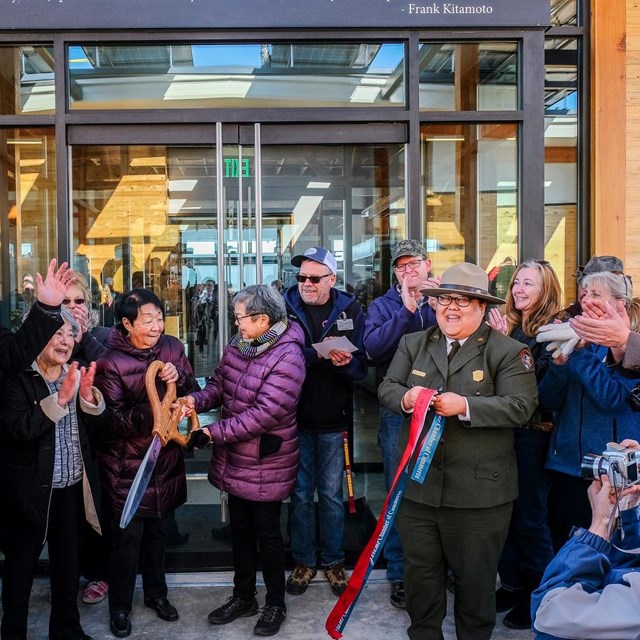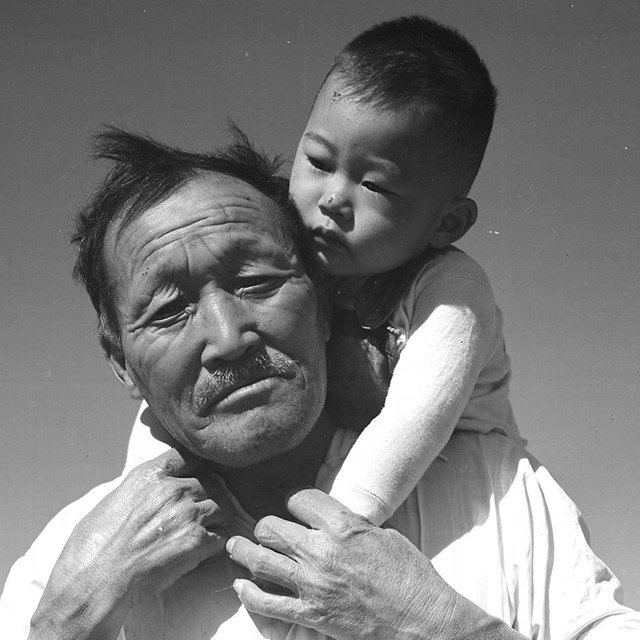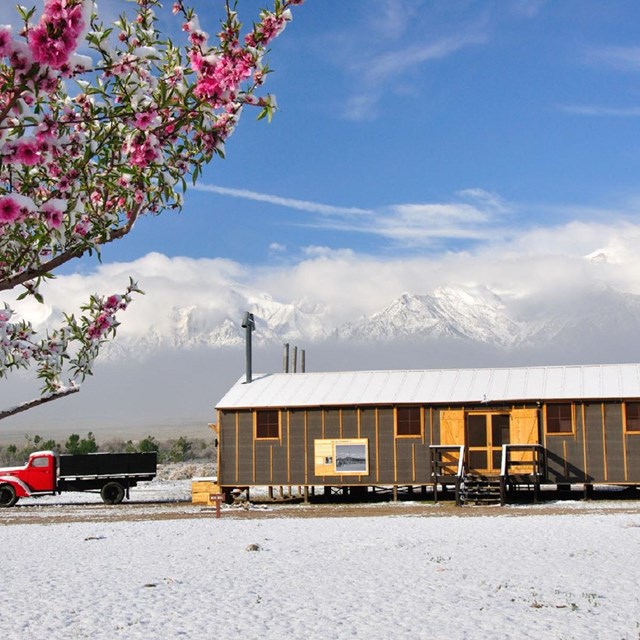February 19, 2022, marks 80 years of racial reckoning since the signing of Executive Order 9066 that led to the wrongful incarceration of 120,000 Japanese Americans during World War II. In 1982, a congressional study found that the incarceration was due to “race prejudice, war hysteria, and a failure of political leadership.” The 1988 Civil Liberties Act, signed by President Ronald Reagan, authorized historic, bipartisan redress and reparation payments to individuals who were incarcerated and a grant program for historical preservation and education.
The National Park Service preserves sites associated with Japanese American incarceration so that visitors and future generations may learn their stories.
On February 18, 2022, a Presidential Proclamation was issued reaffirming the Federal Government's formal apology to Japanese Americans whose lives were affected by this chapter in history and proclaiming February 19, 2022 as a Day of Remembrance of Japanese American Incarceration During World War II.
National Day of Remembrance: 80 Years of Reckoning is a collaborative event co-hosted by the National Park Service, the Smithsonian's National Museum of American History, and the Heart Mountain Wyoming Foundation. Our planning partners are the Japanese American Citizens League, Japanese American National Museum, and Friends of Minidoka. This three-day program is inspired by Smithsonian Secretary Lonnie G. Bunch III’s 2020 initiative “Our Shared Future: Reckoning with Our Racial Past.”
The event will feature an opening program on February 18 and six live-streamed panel discussions on February 19 and 20 led by leaders and subject-matter experts from around the country who will share their experiences and insights related to the history of Japanese American incarceration and its enduring relevance.
National Day of Remembrance: 80 Years of Reckoning
Events Schedule
Friday, February 18

Image and logo courtesy of Ann Fujii.
National Day of Remembrance: 80 Years of Reckoning Opening Program
7:00 p.m. ET/4:00 p.m. PT/2:00 p.m. HT
National Park Service Director Charles F. "Chuck" Sams III is joined by the Secretary of the Smithsonian Lonnie G. Bunch III and National Museum of American History Elizabeth MacMillan Director Anthea M. Hartig, PhD, in welcoming the Honorable Koji Tomita, Ambassador of Japan to the United States of America, Chair of the Board of Trustees Japanese American National Museum and former Secretary of Transportation Norman Y. Mineta, representatives of the Biden administration, and noted scholars in this inspiring opening-night ceremony.
Saturday, February 19
Join moderator Erin Aoyama for a series of six 60 to 90-minute panels over two days. Aoyama is a PhD Candidate in American Studies at Brown University, a programs and research fellow at Minidoka National Historic Site, and a curatorial assistant at the Japanese American National Museum.
Panel Discussions
Racial Reckoning and Japanese American Museums
1:00 p.m. ET/10:00 a.m. PT/8:00 a.m. HT
As our nation continues to wrestle with its long and complex history of racial injustice, join us as we look back on another moment of reckoning: the Japanese American community's struggle for recognition and redress. Since the early days of the redress movement, museums have played a powerful supporting role in this work. In this session, hear from cultural and museum leaders about early exhibitions that set the stage for much of the ongoing work that national and community institutions are undertaking today.
Kevin Gover, Under Secretary for Museums and Culture at the Smithsonian, will open this panel by introducing the Smithsonian’s “Our Shared Future” initiative and explaining the role that museums can play in the national conversation about race. The panel will then explore how museums and historic sites in the present day are rising to meet the current moment.
Speakers: Kevin Gover (Smithsonian), Dr. Franklin Odo (Amherst College, Smithsonian Asian Pacific American Center), Karen Ishizuka (Japanese American National Museum ), Hanako Wakatsuki (National Park Service), Shirley Ann Higuchi (Heart Mountain Wyoming Foundation), Ann Burroughs (Japanese American National Museum)
Creating Paths to Justice, Healing, and Renewal
3:00 p.m. ET/noon PT/10:00 a.m. HT
Though we have come so far as a community, in large part thanks to the truth-telling jump started by the redress movement, there is still much work to be done to promote education and healing within the Japanese American community and to advocate for other marginalized groups. This panel will feature community members who are doing this work through annual events, consortia, virtual pilgrimages, advocacy, and creating new paths to justice and healing.
Speakers: Karen Korematsu (Fred T. Korematsu Institute, Fred Korematsu Day), Mia Russell (Japanese American Confinement Sites Consortium), Kimiko Marr (Japanese American Memorial Pilgrimages), Barbara Takei (Tule Lake Committee), Mike Ishii (NYC Day of Remembrance and Tsuru for Solidarity)
Day of Remembrances: Standing for Redress and Reclaiming History
5:00 p.m. ET/2:00 p.m. PT/noon HT
As we commemorate the 80th anniversary of the signing of EO 9066, we must also take time to celebrate how the community has reclaimed this date to seek justice. Day of Remembrances sprang up across the country after the first one held in 1978 in Seattle, Washington, planned by leaders Frank Chin and Henry Miyatake. They created a groundswell of support for U.S. government reparations and redress. Frank Abe assisted in organizing that first event. In this panel, Frank Abe and Susan Hayase will discuss the evolution of these events through first person accounts. Historian Brian Niiya and JACL Executive Director David Inoue will reflect on the legacy of the Day of Remembrance, and discuss its role in the Japanese American community today.
Speakers: Frank Abe (Resisters.com), Susan Hayase (San Jose Nikkei Resisters), David Inoue (Japanese American Citizens League), Brian Niiya (Densho)
Sunday, February 20
Restorative Justice and Healing in Preservation and Interpretation Through Community Engagement
1:00 p.m. ET/10:00 a.m. PT/8:00 a.m. HT
One of the most important places to address race and injustice is the historical landscape itself. In preserving and interpreting the sites of Japanese American history and confinement, it is key to engage the community in a meaningful way. This panel will feature site managers and community members who are working together to address a wide range of issues and to seek justice through preservation and education.
Speakers: Dakota Russell (Heart Mountain Wyoming Foundation), Dan Sakura (Friends of Minidoka), Kirsten Leong (Amache Alliance), Nate Gyotoku(Japanese Cultural Center of Hawai‘i, Honouliuli National Historic Site), Phil Tajitsu Nash (Japanese Latin Americans, Campaign for Justice)
Historic Preservation and Engagement Through the Arts
3:00 p.m. ET/noon PT/10:00 a.m. HT
The relationship between art and history is ever evolving and powerful. Art can be an artifact of history; history can inspire art. Join us for this panel with four Nikkei artists who have drawn inspiration from their efforts to understand and educate about Japanese American incarceration during World War II. Each artist will share their process and how their work has been influenced by this very personal history.
Speakers: Derek Mio (Actor), Nikki Nojima Louis (New Mexico Japanese American Citizens League), Erin Shigaki (Purple Gate Design, Minidoka Pilgrimage Planning Committee, and Tsuru for Solidarity), traci kato-kiriyama (Tuesday Night Project), Setsuko Winchester (Yellow Bowl Project)
Passing on the Torch and Empowering the Community
5:00 p.m. ET/2:00 p.m. PT/noon HT
The Japanese American community is resilient and continues to inspire the next generation, our elders, and other communities. As the generation that experienced the incarceration passes on, the next generation feels a pressing responsibility to continue the stewardship of this history and connect it to larger social justice causes. Join these five inspiring leaders who embrace this challenge in their everyday work and lead the next generation.
Speakers: Bryce Ikemura (Kizuna), Connie Masuoka (Portland Japanese American Citizens League), Vinicius Taguchi (Twin Cities Japanese American Citizens League), Erika Moritsugu (White House), Jeffery Robinson (American Civil Liberties Union, Producer, "Who We Are: A Chronicle of Racism in America")
Planning Partners
National Park Service
Smithsonian’s National Museum of American History
Heart Mountain Wyoming Foundation
Japanese American Citizens League
Japanese American National Museum
Friends of Minidoka
White House Initiative on Asian Americans, Native Hawaiians, and Pacific Islander
Community Partners
Amache Alliance
Densho
Japanese American Citizens League - Washington, DC
Japanese American Confinement Sites Consortium
Japanese Cultural Center of Hawai‘i
Japanese Latin Americans, Campaign for Justice
Japanese American Memorial Pilgrimages
Kizuna
National Japanese American Memorial Foundation
New Mexico Japanese American Citizens League
NYC DOR
Resisters.com
San Jose Nikkei Resisters
Smithsonian Asian Pacific American Center
Smithsonian Folkways Recording
The Asian American Foundation
Tsuru for Solidarity
Tuesday Night Project
Tule Lake Committee
Portland JACL
Purple Gate Design
The Who We Are Project
Twin Cities JACL
Yellow Bowl Project
About the Day of Remembrance Logo: Artist Frank S. Fujii was incarcerated at Tule Lake Camp Segregation Center during World War II. He created this logo in 1978 for the first Day of Remembrance event in Seattle and used it to promote the effort to earn reparations and redress for Japanese Americans incarcerated during World War II. It was Fujii’s hope that others in the community would also use it. The circular logo incorporates an image of barbed wire and a graphic representation of first, second, and third generations as it evokes the traditional style of a Japanese family crest. Special thanks to Ann Fujii for permission to use the graphic.
Related Topics
-
 Events
EventsJoin events at national park sites, including commemorations, partnership programs, and ranger and volunteer talks.
-
 Stories of the Past and Present
Stories of the Past and PresentLearn about the people and families whose lives were forever changed during World War II.
-
 Visit Places
Visit PlacesLearn more about Japanese American incarceration at these national park sites.
Last updated: February 18, 2022
